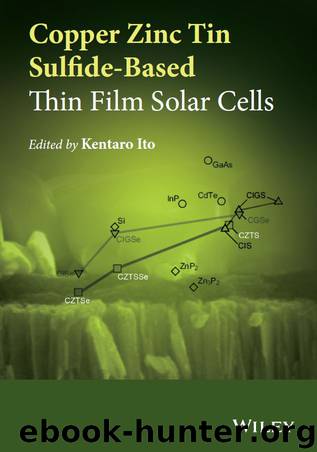Copper Zinc Tin Sulfide-Based Thin Film Solar Cells by Kentaro Ito

Author:Kentaro Ito [Ito, Kentaro]
Language: eng
Format: epub
ISBN: 9781118437858
Publisher: Wiley
Published: 2014-12-09T00:00:00+00:00
Figure 8.16 Comparison of J–V characteristics of CZTS thin-film solar cells. The dipping time at the CBD process was set as a parameter
Figure 8.17 EQE spectra of CZTS thin-film solar cells. These cells are the same as those depicted in Figure 8.16
To evaluate the effect of the series resistance on these cells, we focused on J–V curves in the vicinity of Voc. In our experiment, about 20 cells of 4 × 4 mm2 area were fabricated on the substrate of 25 × 25 mm2. After measuring the J–V characteristics of all cells, three cells having the highest conversion efficiency in one substrate were selected. The average series resistance of these three cells in each sample was 6.36 Ω cm2 for 10 min, 7.35 Ω cm2 for 15 min, 10.5 Ω cm2 for 20 min, and 9.49 Ω cm2 for 25 min. In this experiment, all processes were performed on the same batch while the dipping time for CBD was varied as above. Series resistances should therefore only depend on the thickness of CdS. In fact, the series resistance increased by increasing the dipping time, and then tended to be saturated. Furthermore, when the dipping time was longer we were able to see that the incremental decrease of EQE in the shorter-wavelength region was suppressed as shown in Figure 8.17. We interpret this as further evidence of the saturation of CdS thickness with the dipping time.
Download
This site does not store any files on its server. We only index and link to content provided by other sites. Please contact the content providers to delete copyright contents if any and email us, we'll remove relevant links or contents immediately.
| Automotive | Engineering |
| Transportation |
Whiskies Galore by Ian Buxton(41541)
Introduction to Aircraft Design (Cambridge Aerospace Series) by John P. Fielding(32893)
Small Unmanned Fixed-wing Aircraft Design by Andrew J. Keane Andras Sobester James P. Scanlan & András Sóbester & James P. Scanlan(32581)
Craft Beer for the Homebrewer by Michael Agnew(17938)
Turbulence by E. J. Noyes(7718)
The Complete Stick Figure Physics Tutorials by Allen Sarah(7151)
Kaplan MCAT General Chemistry Review by Kaplan(6606)
The Thirst by Nesbo Jo(6451)
Bad Blood by John Carreyrou(6286)
Modelling of Convective Heat and Mass Transfer in Rotating Flows by Igor V. Shevchuk(6231)
Learning SQL by Alan Beaulieu(6043)
Weapons of Math Destruction by Cathy O'Neil(5853)
Man-made Catastrophes and Risk Information Concealment by Dmitry Chernov & Didier Sornette(5673)
Digital Minimalism by Cal Newport;(5397)
Life 3.0: Being Human in the Age of Artificial Intelligence by Tegmark Max(5198)
iGen by Jean M. Twenge(5170)
Secrets of Antigravity Propulsion: Tesla, UFOs, and Classified Aerospace Technology by Ph.D. Paul A. Laviolette(5013)
Design of Trajectory Optimization Approach for Space Maneuver Vehicle Skip Entry Problems by Runqi Chai & Al Savvaris & Antonios Tsourdos & Senchun Chai(4849)
Electronic Devices & Circuits by Jacob Millman & Christos C. Halkias(4757)
